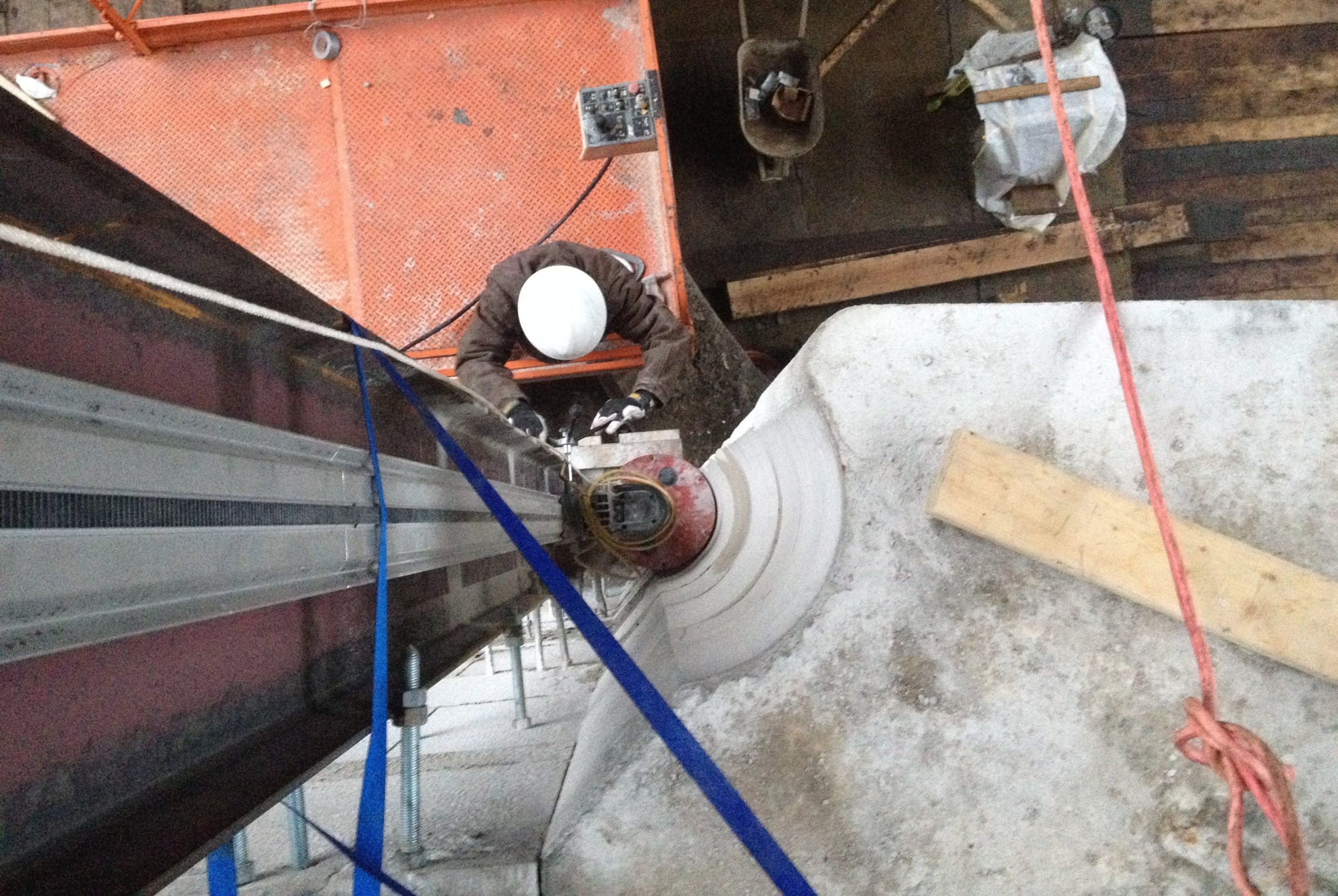
Changing the Locks

Core Drilling Key to Canal Restoration

The contractor was tasked with core drilling quoin post sockets for restoration purposes.
The advantages of core drilling with diamond tools have helped architects and engineers realize the completion of successful projects for many years. Often, core drilling techniques are used for the installation of modern elements that enhance or stregnthen an existing bulding or structure. This past April, however, a cutting contractor was asked to help with a $1.7-million restoration project that would return a canal lock to its original design. The project involved creating almost 50 feet of partial-diameter core drill openings through 150-year-old stone walls.
In order to reach Lake Erie from the Hudson River in New York, the Erie Canal has to surmount the Niagara Escarpment at Lockport. In the early 1800s, a competition was launched by the canal owners to design a series of locks that would help vessels traverse over the escarpment. The competition was won by Nathan Roberts, a mathematics teacher and land speculator. His design consisted of two pairs of locks so that one flight could be used for boats going uphill north on the canal and the other for boats going downhill south, saving a significant amount of time and water consumption. The locks were constructed from 1817 to 1825 and some were later modified in 1864.
The south flight of locks has since been demolished and replaced by a pair of New York State Barge Canal locks, while the north flight—also know as the “Flight of Five”—has not been modified since the 1860s. Having fallen into disrepair, the Flight of Five is now the focus of a $1.7-million restoration project that has been underway for 10 years. Phase One is due for completion in late summer of 2014. Phase One includes masonry repairs, new lights, the installation of arched bridges and the restoration of historic railings around the locks. The centerpiece of the work, however, is the installation of authentic working wooden gates at two lock locations—Locks #69 and #70. The gates operate manually, just as the originals did when the locks were first constructed.
CSDA member MMG Industrial of Buffalo, New York, was contracted by Hohl Industrial to provide precision drilling and sawing services around parts of the concrete and stone construction at Lock #69. Having been in place for around 150 years, it was found that the walls of the lock had begun to lean inward and were approximately 4 inches out of plumb on either side. In order to return the lock to service and install the new wooden doors with a proper seal, it was imperative that the wall sockets or ‘quoin post sockets’ were amended and brought back to plumb. Quoin posts are the vertical posts at the hinged end of a lock gate on which the gate pivots. The posts are housed in curved sockets within the lock walls.
“We utilized our field machining and stone cutting experience collaboratively to create a 30-foot-long, track-mounted system on both of the lock walls,” said Matt Gehman, owner of MMG Industrial. “The track-mounted systems stood vertically and allowed for the precise control of a core drilling system to recut the partial-diameter quoin sockets on both walls.”
There were two existing sockets that needed to be adjusted, with the requirement that they both were returned to plumb and provided 120 degrees of movement for the lock doors when completed. Therefore, MMG set up its drilling system to create 14-inch partial-diameter sockets down 30-foot-deep sections of stone lock walls. The cut surface covered a 120-degree radius of the core bit and each drilling run cored through eleven 30-inch-thick stone courses on the way down.
Due to the requirements of the job and the age of the structure, MMG knew cutting with diamond tools was the only feasible option. The job required the cutting of non-homogenous reinforced materials that were 150 years old, so core drilling provided the precise, controlled movement and low vibration needed to minimize the possibility of misplacement or loss of strucural integrity. MMG conducted a detailed site inspection to determine the optimal cutting method and achievable tolerances, after which CAD drawings were created to present the track-mounted drilling system to the general contractor. Following approval, the cutting contractor got to work.

A 14-inch-diameter core bit was used to drill 24 feet down the lock wall.
A Hilti DD350 core drill was procured with 36-inch-long, 14-inch-diameter bits. The manufacturer also supplied nine 4-foot sections of track to mount to the contractor’s 24-inch, 30-foot-long I-beams. MMG’s sister company, MLS Machine, modified the track system and I-beams to ensure proper alignment, as only a tolerance of +/- 0.030 inches was allowed down the entire 24-foot depth of the cuts.
Access to the entire height of the lock walls was difficult due to ongoing work by the general contractor, so a portable crane was utilized to lower a four-wheel drive, 30-foot scissor lift to the bottom of the lock. This allowed the contractor to quickly set up and adjust the position of the core drilling crew without disturbing other workers. The crane was also used to position the track-mounted drilling system, which was attached to the lock wall by concrete anchors. The contractor then used jack screws to precisely adjust the system against the stone wall.
A core drilling operator began work on the first quoin socket, dilling approximately 18 inches per hour through the stone courses. The track-mounted system took approximately two eight-hour shifts to drill down 24 feet to the bottom of the lock wall. The system was then detached and repositioned at the second quoin post socket location and the process repeated. After each drill run, measurements were taken to insure the new sockets were plumb and the specified distance from the lock center.
“The only major hurdle on this project was cutting a partial diameter (120-degree segment) through 30-inch-thick stone blocks. The extended core bit needed to be supported at the top and bottom to prevent ‘camming’ of the bit and stalling of the drive system. The non-homogenous material, along with the occasional bit of steel reinforcement, meant keeping the cut on centerline was a challenge,” explained Gehman. In addition, the inward lean of the lock walls meant the contractor had to start with a heavy cut at the top and blend to almost nothing at the bottom to return the socket to plumb.
Having successfully created new quoin post sockets at Lock #69, the contractor was awarded more cutting work at the jobsite. A task was added to adjust a door support on the concrete floor of the lock. The support is essentially a 1-foot-tall concrete step that prevents either door from closing in too far when the lock is in operation. An operator used a 695F4 gas-powered chain saw from ICS to trim approximately 1 inch off the side of the support to compensate for the adjustments made by the core drilling work. Cuts were made at specificed angles so that they met at the correct tangent point from the quoin post sockets, taking eight hours to complete.
As the project involved cutting with demolition tools on a structure that was old and in need of restorative work, safety was at the forefront of all tasks. All perimeter railings had been removed for refurbishment, so the scissor lift became a very important piece of equipment for providing a safe working platform. Extention ladders and tie-offs were used to complete work, where required.
During the contractor’s work at Lock #69 at Lockport, MMG Industrial performed 48 feet of vertical core drilling through the stone lock walls and made 24 feet of chain saw cuts to remove a 1-foot-tall, 1-inch-wide slice of reinforced concrete from the door support on the lock floor. The project completed ahead of schedule and within the quoted budget. While the original scope of work was only to core the quoin post sockets pockets, the task of cutting the floor door support was also awarded to MMG. Hohl Industrial was very pleased with the outcome, especially with the fact that all work was completed within the tolerances specified.
“The Flight of Five project was very satisfying in that it required the combination of two disciplines to achieve the desired result—portable machining and concrete cutting. The general contractor originally approached us because of our experience in field machining techniques. They initially thought that this project would be a ‘machining or grinding’ job as the quoin socket was only a 120-degree segment of a full diameter. They didn’t feel that a coring bit would be able to stay on center and within the tolerance needed. However, we convinced them that a combination of efforts (machining setup with core bits) would be the best approach and they deffered to our experience and recommendations,” concluded Gehman.”
Company Profile
MMG Industrial has been a CSDA member since 2009 and was established in 1998. The company is based in Buffalo, New York, has two trucks, employs 30 people and services all mainland states of the U.S. MMG Industrial offers the services of flat sawing, core drilling, wall sawing and wire sawing and specializes in the cutting of metals.
Resources
General Contractor:
Hohl Industrial
Sawing and Drilling Contractor:
MMG Industrial
Buffalo, New York
Phone: 716-348-3434
Email: mattg@diamondwirecutting.com
Methods Used: Core Drilling, Hand Sawing















![Semper Paratus [Always Ready]](https://www.concreteopenings.com/wp-content/uploads/2014/11/1-Photo-6-e1424382046143-scaled.jpg)